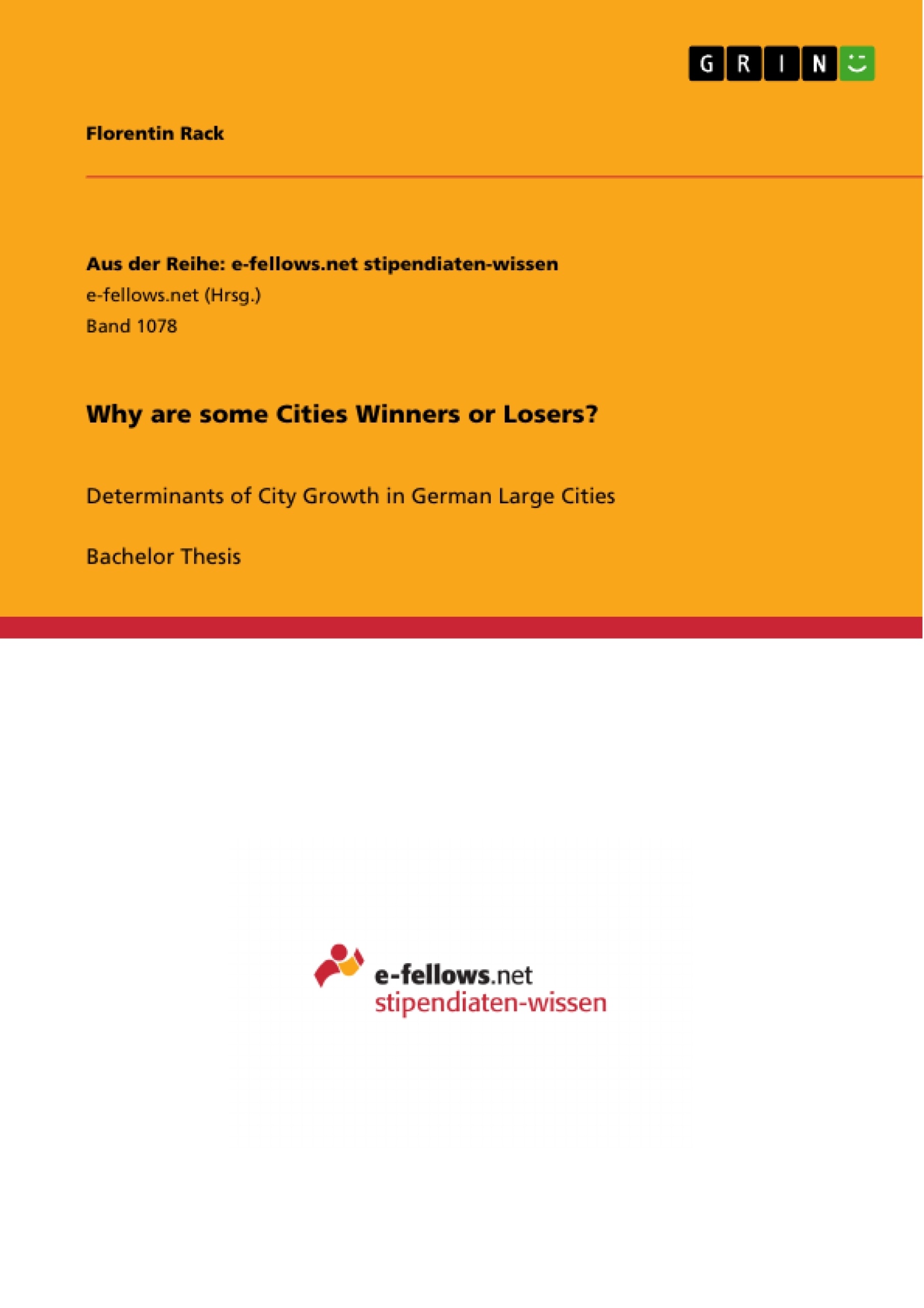The aim of this bachelor thesis is to find out what drives city growth in
Germany. It shall find out what are the determinants that make large cities gain or lose
inhabitants.
Especially in Eastern Germany after the reunification there have been some
“winner cities” such as Dresden, Leipzig, and Potsdam, and many “loser cities” such as
Chemnitz, Magdeburg, and Schwerin. In the last decades, a similar separation between
winners and losers has arisen also in Western Germany. So what is the reason for this
division into two groups of cities?
The research is very relevant for city governments and real estate owners or
investors. Emigration of the working populace and few births lower the tax earnings and
raise the necessary public expenses a city has to bear, while the opposite makes a city
thrive fiscally, financially, and economically. Rents and land prices depend on the
development of the city size: shrinking cities have horrendous vacancy rates, while
prices are exploding in growing cities. Knowing what the reasons for city growth shrinkage are enables city governors to adapt the right policies to make their city
become an exception of the overall demographic collapse in Germany or to turn around
a dangerous progress. Knowing these reasons also enables real estate investors to
predict future demand for residential, office, and retail space, and to decide whether
properties are under or overpriced.
Inhaltsverzeichnis (Table of Contents)
- Introduction
- Theories of City Growth and City Size Distributions
- Literature Review
- Which Theory fits Germany?
- Determinants of City Growth
- Basic Determinants
- Demographic Factors
- Social Factors
- Geographic Factors
- Infrastructural Factors
- Institutional Factors
- Economic Factors
- External Factors
- Basic Factors
- Uniting the Findings into an Overarching Model
- Testing the Model
- Included Data
- Tested Variables
- Excluding Outliers from the Model
- Results for the First Regressions
- Multiple Regressions
- Model 1
- Model 2
- Optimizing the Model
- Model 3
- Model 4
- Further Modifications
- Interpretation of the Results
- First Main Finding
- Second Main Finding
- Third Main Finding
- Fourth Main Finding
- Ideas for Further Research
Zielsetzung und Themenschwerpunkte (Objectives and Key Themes)
This bachelor thesis aims to identify the determinants of city growth in Germany, specifically focusing on factors that contribute to large cities gaining or losing inhabitants. The research seeks to understand the reasons behind the emergence of "winner cities" and "loser cities" in both Eastern and Western Germany.- Factors contributing to city growth in Germany
- Analysis of "winner cities" and "loser cities" in Eastern and Western Germany
- The impact of demographic, social, economic, and infrastructural factors on city growth
- Development and testing of a model to predict city growth
- Relevance of findings for city governments, real estate owners, and investors
Zusammenfassung der Kapitel (Chapter Summaries)
- The introduction highlights the phenomenon of city decline, illustrated by the examples of Detroit and Duisburg. It emphasizes the importance of understanding the factors driving city growth and the potential benefits of predicting population trends.
- Chapter 2 provides a comprehensive overview of existing theories on city growth and city size distributions. It examines different theoretical perspectives and discusses their applicability to the German context.
- Chapter 3 delves into a wide range of factors that influence city growth, including basic determinants, demographic factors, social factors, geographic factors, infrastructural factors, institutional factors, economic factors, external factors, and basic factors.
- Chapter 4 presents a unified model that combines the findings from previous chapters into an overarching framework for understanding city growth.
- Chapter 5 outlines the methodology used to test the proposed model, detailing the data sources, variables, and statistical methods employed. It presents the results of both simple and multiple regressions, highlighting key findings and potential outliers.
- Chapter 6 provides a comprehensive interpretation of the results, discussing the implications of the research findings for city planning, policymaking, and urban development.
Schlüsselwörter (Keywords)
This work focuses on the determinants of city growth in Germany, exploring the factors that lead to the emergence of "winner cities" and "loser cities." The research examines the influence of various factors on urban development, including demographics, social factors, economic factors, infrastructure, and institutional factors. The study employs a quantitative approach, utilizing statistical models and data analysis to test the proposed model of city growth.- Quote paper
- Florentin Rack (Author), 2014, Why are some Cities Winners or Losers?, Munich, GRIN Verlag, https://www.grin.com/document/286504



